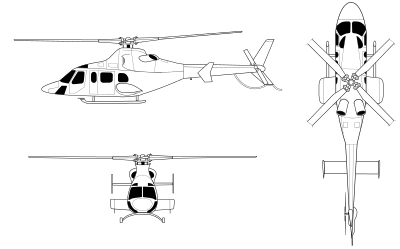Bell 430
Summary
| Category | Military Helicopter |
| Origin country | 🇺🇸 United States |
| Manufacturer | Bell |
| First flight | 25 October 1994 |
| Year introduced | 1995 |
| Number produced | 136 units |
| Average unit price | $10 million |
Description
While developing the re-engined Model 222 as the 230, Bell initiated preliminary design work on a stretched derivative incorporating a four-bladed main rotor in 1991. The Bell 430 was formally launched in February 1992, with two prototypes modified from Bell 230s. The first of these flew in its new configuration on October 25, 1994, and the second prototype, featuring the full 430 avionics suite, first flew on December 19, 1994. Production of the Bell 230 concluded in August 1995, paving the way for 430 production to commence, with the first production aircraft completed later that year. Canadian certification was awarded on February 23, 1996, and deliveries began in mid-1996. On January 24, 2008, Bell announced plans to terminate production of the Model 430 after order commitments were fulfilled in 2008; production ended after 136 helicopters were completed, with the last being delivered in May 2008.
The Bell 430 incorporates a four-blade, bearingless, hingeless, composite main rotor. The fuselage is stretched by 1 ft 6 in (46 cm), providing space for two additional seats. An optional EFIS (Electronic Flight Instrument System) flight deck is available. The aircraft is offered with a choice of either skids or a retractable wheeled undercarriage. Maximum external load capacity is 3,500 pounds (1,600 kg).
The Bell 430 entered service in 1996, with thirteen aircraft delivered that year, and by 1998, approximately 50 Bell 430s had accumulated 9,000 flight hours. The helicopter has seen use in both military and civilian roles across several countries. Operators include the Bulgarian Air Force, Dominican Republic Air Force, and Ecuadorian Navy, as well as civilian entities such as Pelita Air in Indonesia, AirMed, New York State Police, Lee County EMS, GrandView Aviation, Louisiana State Police, and Uber Elevate in the United States. A round-the-world helicopter record was set on September 3, 1996, when Americans Ron Bower and John Williams completed a westward flight from the UK in a Bell 430 in 17 days, 6 hours, and 14 minutes. An accident occurred on September 2, 2009, when an Andhra Govt. Bell 430 carrying Chief Minister Y. S. Rajasekhara Reddy and his party crashed in the Nallamala Hills in southern India, resulting in five fatalities.
Main Variants:
-
Initial Production Model: The original Bell 430, featuring a four-blade rotor system and a stretched fuselage for increased passenger capacity.
-
EFIS-Equipped Variant: An upgraded version incorporating an Electronic Flight Instrument System (EFIS).
-
EMS Configuration: A specialized variant configured for emergency medical services, capable of carrying one or two stretcher patients along with medical attendants.
-
Executive Layouts: Customized versions offering six- or eight-place seating arrangements.
-
Skid or Wheeled Undercarriage Options: Models available with either traditional skid landing gear or retractable wheeled undercarriage.
Technical specifications
| Version: Bell 430 | |
|---|---|
| Crew | 1 pilot |
| Maximum speed | 278 km/h (173 mph) |
| Height | 3.8 m (12.3 ft) |
| Length | 15.3 m (50.2 ft) |
| Service ceiling | 6,096 m (20,000 ft) |
| Empty weight | 2,406 kg (5,304 lbs) |
| Max. takeoff weight | 4,218 kg (9,299 lbs) |
| Climb rate | 6.858 m/s (22.5 ft/s) |
| Powerplant | 2 × turbines Allison 250-C40B delivering 585 kW |
Current operating countries
| Country | Units | ||
|---|---|---|---|

|
Ecuador | 4 | |

|
Dominican Republic | 1 | |
All operators

